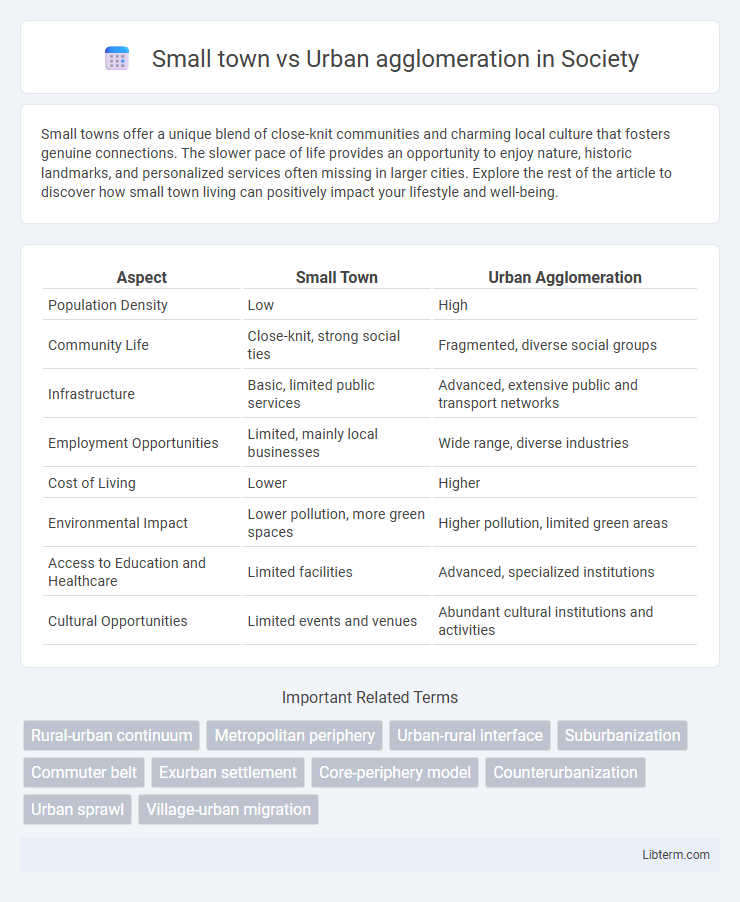Small towns offer a unique blend of close-knit communities and charming local culture that fosters genuine connections. The slower pace of life provides an opportunity to enjoy nature, historic landmarks, and personalized services often missing in larger cities. Explore the rest of the article to discover how small town living can positively impact your lifestyle and well-being.
Table of Comparison
| Aspect | Small Town | Urban Agglomeration |
|---|---|---|
| Population Density | Low | High |
| Community Life | Close-knit, strong social ties | Fragmented, diverse social groups |
| Infrastructure | Basic, limited public services | Advanced, extensive public and transport networks |
| Employment Opportunities | Limited, mainly local businesses | Wide range, diverse industries |
| Cost of Living | Lower | Higher |
| Environmental Impact | Lower pollution, more green spaces | Higher pollution, limited green areas |
| Access to Education and Healthcare | Limited facilities | Advanced, specialized institutions |
| Cultural Opportunities | Limited events and venues | Abundant cultural institutions and activities |
Introduction: Defining Small Towns and Urban Agglomerations
Small towns are characterized by smaller populations, limited infrastructure, and a close-knit community structure, typically ranging from a few thousand to tens of thousands of residents. Urban agglomerations, on the other hand, consist of densely populated metropolitan regions formed by the continuous expansion of multiple cities and towns, often exceeding millions in population. The distinction lies in population density, economic complexity, and spatial continuity, with urban agglomerations representing extensive, integrated urban landscapes.
Population Density and Community Lifestyle
Small towns typically exhibit low population density, fostering close-knit community relationships and a slower-paced lifestyle characterized by strong social ties and local engagement. Urban agglomerations, by contrast, feature high population density, resulting in diverse, dynamic environments with a fast-paced lifestyle and a blend of cultural and economic activities. The contrast in population density profoundly shapes the community lifestyle, influencing social interactions, infrastructure development, and access to services.
Economic Opportunities and Job Markets
Small towns often offer limited economic opportunities with a focus on local businesses, agriculture, or small-scale industries, leading to fewer job options and slower career growth. Urban agglomerations boast diverse job markets driven by multiple sectors such as finance, technology, manufacturing, and services, attracting a skilled workforce and fostering innovation. The high density of businesses and infrastructure in urban agglomerations enables greater entrepreneurship, higher wages, and dynamic employment trends compared to small towns.
Housing Costs and Living Standards
Housing costs in small towns generally remain lower due to reduced demand and lower land prices, making homeownership more accessible compared to urban agglomerations where high population density drives up property prices. Living standards in urban agglomerations benefit from better access to healthcare, education, and infrastructure, yet this often comes at the expense of higher living expenses and congestion. Small towns offer a quieter lifestyle and affordable housing but may lack diverse employment opportunities and advanced public services found in larger metropolitan areas.
Education and Healthcare Access
Small towns often face limited access to advanced education and specialized healthcare services due to fewer institutions and resources compared to urban agglomerations. Urban agglomerations provide diverse educational opportunities, including universities and vocational training centers, alongside state-of-the-art healthcare facilities equipped with specialized medical professionals. The disparity in access affects community health outcomes and educational attainment, highlighting the need for targeted investments in rural education and healthcare infrastructure.
Transportation and Infrastructure
Small towns typically have limited transportation options, relying mainly on local roads and minimal public transit systems, which can hinder connectivity and economic growth. In contrast, urban agglomerations boast extensive infrastructure networks, including highways, rail systems, airports, and advanced public transportation, supporting high population density and facilitating efficient mobility. Investment in urban infrastructure enhances accessibility, reduces traffic congestion, and supports sustainable development strategies.
Social Connections and Community Engagement
Small towns often foster close-knit social connections and higher levels of community engagement due to smaller populations and more frequent face-to-face interactions. Urban agglomerations, despite their larger populations, tend to have more diverse but fragmented social networks, with community engagement varying widely across neighborhoods. The scale and density of urban areas can both challenge and enhance social connections, depending on local institutions and public spaces that encourage participation.
Environmental Impact and Sustainability
Small towns generally exhibit lower environmental impact due to reduced population density and less industrial activity, promoting better air quality and localized waste management. Urban agglomerations often face significant sustainability challenges, including higher carbon emissions, extensive resource consumption, and increased pollution levels. Efficient public transportation, green infrastructure, and stringent environmental policies are critical in mitigating these impacts within large urban areas.
Quality of Life and Personal Well-being
Small towns often provide higher quality of life through lower pollution levels, less traffic congestion, and stronger community connections fostering personal well-being. Urban agglomerations offer extensive access to healthcare, education, and cultural amenities, which can enhance mental and physical health but also introduce stress factors like noise and overcrowding. Balancing these dynamics, residents in small towns typically experience greater tranquility and social cohesion, while urban dwellers benefit from diverse opportunities and services that contribute to overall well-being.
Future Trends: Migration and Urbanization
Small towns are experiencing slower population growth compared to urban agglomerations, which continue to attract significant migration due to expanding economic opportunities and infrastructure development. Urban agglomerations are projected to see intensified urbanization driven by technological advancements and the rise of smart cities, making them centers of innovation and employment. Migration patterns indicate a sustained influx into larger metropolitan areas, while small towns may face challenges retaining residents without strategic investment and modernization.
Small town Infographic

 libterm.com
libterm.com